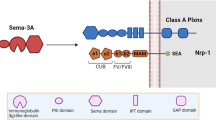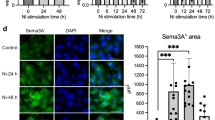Abstract
Semaphorin 3A (Sema3A), an axon guidance molecule, inhibits neurite outgrowth of sensory neurons. Recombinant Sema3A protein has also inhibited scratching behavior and improved skin inflammation in an atopic dermatitis model. In the present study, we investigated whether Sema3A-derived peptides could bind its receptor, neuropilin-1 (NRP1), to inhibit neurite outgrowth. Here, two candidate NRP1-binding (NPB) peptides, NPB7 and NPB15, were found to inhibit NGF-induced survival and neurite outgrowth of PC12 cells and rat primary neurons in serum-free medium. To investigate the preventive effect of the two NPB peptides in vivo, we assessed whether they could inhibit skin inflammation induced by repeated topical application of oxazolone in mice. NPB15 peptide, but not NPB7, inhibited ear swelling. The NPB15 peptide solution and Vaseline ointment groups showed slightly decreased epidermal nerve densities compared with controls. The combination of NPB15 peptide and Vaseline ointment increased the inhibitory effect of NPB15 peptide on epidermal nerve densities. These results suggest that Sema3A-derived peptides can bind to NRP1 and inhibit neurite outgrowth both in vitro and in vivo. Thus, these peptides may be potent candidates for the treatment of atopic dermatitis.




Similar content being viewed by others
Abbreviations
- AD:
-
Atopic dermatitis
- cGMP:
-
Cyclic guanosine monophosphate
- END:
-
Epidermal nerve density
- FBS:
-
Fetal bovine serum
- NGF:
-
Nerve growth factor
- NPB:
-
NRP1-binding
- NRP1:
-
Neuropilin-1
- OCD:
-
Oxazolone-induced chronic dermatitis
- rhNRP1:
-
Recombinant human NRP1
- rhSema3A:
-
Recombinant human semaphorin 3A/Fc chimera
- Sema3A:
-
Semaphorin 3A
- SPR:
-
Surface plasmon resonance
References
Ahmed I, Kaspar B, Sharma U (2012) Biosimilars: impact of biologic product life cycle and European experience on the regulatory trajectory in the United States. Clin Ther 34:400–419
Alawadhi A, Alawneh K, Alzahrani ZA (2012) The effect of neutralizing antibodies on the sustainable efficacy of biologic therapies: what’s in it for African and Middle Eastern rheumatologists. Clin Rheumatol 31:1281–1287
Antipenko A, Himanen JP, van Leyen K, Nardi-Dei V, Lesniak J, Barton WA, Rajashankar KR, Lu M, Hoemme C, Püschel AW, Nikolov DB (2003) Structure of the semaphorin-3A receptor binding module. Neuron 39:589–598
Bos JD, Meinardi MM (2000) The 500 Dalton rule for the skin penetration of chemical compounds and drugs. Exp Dermatol 9:165–169
Catalano A, Caprari P, Moretti S, Faronato M, Tamagnone L, Procopio A (2006) Semaphorin-3A is expressed by tumor cells and alters T-cell signal transduction and function. Blood 107:3321–3329
Fan J, Raper JA (1995) Localized collapsing cues can steer growth cones without inducing their full collapse. Neuron 14:263–274
Frostell-Karlsson A, Remaeus A, Roos H, Andersson K, Borg P, Hämäläinen M, Karlsson R (2000) Biosensor analysis of the interaction between immobilized human serum albumin and drug compounds for prediction of human serum albumin binding levels. J Med Chem 43:1986–1992
Hesse D, Sørensen PS (2007) Using measurements of neutralizing antibodies: the challenge of IFN-beta therapy. Eur J Neurol 14:850–859
Hong TM, Chen YL, Wu YY, Yuan A, Chao YC, Chung YC, Wu MH, Yang SC, Pan SH, Shih JY, Chan WK, Yang PC (2007) Targeting neuropilin 1 as an antitumor strategy in lung cancer. Clin Cancer Res 13:4759–4768
Ikoma A, Steinhoff M, Ständer S, Yosipovitch G, Schmelz M (2006) The neurobiology of itch. Nat Rev Neurosci 7:535–547
Kakurai M, Monteforte R, Suto H, Tsai M, Nakae S, Galli SJ (2006) Mast cell-derived tumor necrosis factor can promote nerve fiber elongation in the skin during contact hypersensitivity in mice. Am J Pathol 169:1713–1721
Kato K, Utani A, Suzuki N, Mochizuki M, Yamada M, Nishi N, Matsuura H, Shinkai H, Nomizu M (2002) Identification of neurite outgrowth promoting sites on the laminin alpha 3 chain G domain. Biochemistry 41:10747–10753
Kawamoto M, Horibe T, Kohno M, Kawakami K (2011) A novel transferrin receptor-targeted hybrid peptide disintegrates cancer cell membrane to induce rapid killing of cancer cells. BMC Cancer 11:359
Kawamoto M, Horibe T, Kohno M, Kawakami K (2013a) HER2-targeted hybrid peptide that blocks HER2 tyrosine kinase disintegrates cancer cell membrane and inhibits tumor growth in vivo. Mol Cancer Ther 12:384–393
Kawamoto M, Kohno M, Horibe T, Kawakami K (2013b) Immunogenicity and toxicity of transferrin receptor-targeted hybrid peptide as a potent anticancer agent. Cancer Chemother Pharmacol 71:799–807
Kessler M, Goldsmith D, Schellekens H (2006) Immunogenicity of biopharmaceuticals. Nephrol Dial Transplant 21(Suppl 5):v9–v12
Klein PA, Clark RA (1999) An evidence-based review of the efficacy of antihistamines in relieving pruritus in atopic dermatitis. Arch Dermatol 135:1522–1525
Koblenzer CS (1999) Itching and the atopic skin. J Allergy Clin Immunol 104:S109–S113
Kohno M, Horibe T, Haramoto M, Yano Y, Ohara K, Nakajima O, Matsuzaki K, Kawakami K (2011) A novel hybrid peptide targeting EGFR-expressing cancers. Eur J Cancer 47:773–783
Krumpe LR, Mori T (2006) The use of phage-displayed peptide libraries to develop tumor-targeting drugs. Int J Pept Res Ther 12:79–91
Lepelletier Y, Moura IC, Hadj-Slimane R, Renand A, Fiorentino S, Baude C, Shirvan A, Barzilai A, Hermine O (2006) Immunosuppressive role of semaphorin-3A on T cell proliferation is mediated by inhibition of actin cytoskeleton reorganization. Eur J Immunol 36:1782–1793
Luo Y, Raible D, Raper JA (1993) Collapsin: a protein in brain that induces the collapse and paralysis of neuronal growth cones. Cell 75:217–227
Negi O, Tominaga M, Tengara S, Kamo A, Taneda K, Suga Y, Ogawa H, Takamori K (2012) Topically applied semaphorin 3A ointment inhibits scratching behavior and improves skin inflammation in NC/Nga mice with atopic dermatitis. J Dermatol Sci 66:37–43
Okawa T, Yamaguchi Y, Takada S, Sakai Y, Numata N, Nakamura F, Nagashima Y, Ikezawa Z, Aihara M (2012) Oral administration of collagen tripeptide improves dryness and pruritus in the acetone-induced dry skin model. J Dermatol Sci 66:136–143
Parikh AA, Biao Liu W, Fan F, Stoeltzing O, Reinmuth N, Bruns CJ, Bucana CD, Evans DB, Ellis LM (2003) Expression and regulation of the novel vascular endothelial growth factor receptor neuropilin-1 by epidermal growth factor in human pancreatic carcinoma. Cancer 98:720–729
Piper M, Salih S, Weinl C, Holt CE, Harris WA (2005) Endocytosis-dependent desensitization and protein synthesis-dependent resensitization in retinal growth cone adaptation. Nat Neurosci 8:179–186
Rukenstein A, Rydel RE, Greene LA (1991) Multiple agents rescue PC12 cells from serum-free cell death by translation- and transcription-independent mechanisms. J Neurosci 11:2552–2563
Sasaki Y, Fukushima N, Yoshida A, Ueda H (1998) Low-density induced apoptosis of cortical neurons is inhibited by serum factors. Cell Mol Neurobiol 18:487–496
Shiohara T, Hayakawa J, Mizukawa Y (2004) Animal models for atopic dermatitis: are they relevant to human disease? J Dermatol Sci 36:1–9
Shirvan A, Shina R, Ziv I, Melamed E, Barzilai A (2000) Induction of neuronal apoptosis by Semaphorin3A-derived peptide. Brain Res Mol Brain Res 83:81–93
Song H, Ming G, He Z, Lehmann M, McKerracher L, Tessier-Lavigne M, Poo M (1998) Conversion of neuronal growth cone responses from repulsion to attraction by cyclic nucleotides. Science 281:1515–1518
Takahashi T, Fournier A, Nakamura F, Wang LH, Murakami Y, Kalb RG, Fujisawa H, Strittmatter SM (1999) Plexin-neuropilin-1 complexes form functional semaphorin-3A receptors. Cell 99:59–69
Takamatsu H, Takegahara N, Nakagawa Y, Tomura M, Taniguchi M, Friedel RH, Rayburn H, Tessier-Lavigne M, Yoshida Y, Okuno T, Mizui M, Kang S, Nojima S, Tsujimura T, Nakatsuji Y, Katayama I, Toyofuku T, Kikutani H, Kumanogoh A (2010) Semaphorins guide the entry of dendritic cells into the lymphatics by activating myosin II. Nat Immunol 11:594–600
Takano N, Sakurai T, Kurachi M (2005) Effects of anti-nerve growth factor antibody on symptoms in the NC/Nga mouse, an atopic dermatitis model. J Pharmacol Sci 99:277–286
Tamura T, Matsubara M, Takada C, Hasegawa K, Suzuki K, Ohmori K, Karasawa A (2004) Effects of olopatadine hydrochloride, an antihistamine drug, on skin inflammation induced by repeated topical application of oxazolone in mice. Br J Dermatol 151:1133–1142
Teesalu T, Sugahara KN, Kotamraju VR, Ruoslahti E (2009) C-end rule peptides mediate neuropilin-1-dependent cell, vascular, and tissue penetration. Proc Natl Acad Sci USA 106:16157–16162
Tsukumo Y, Harada D, Manabe H (2010) Pharmacological characterization of itch-associated response induced by repeated application of oxazolone in mice. J Pharmacol Sci 113:255–262
Ueyama H, Horibe T, Nakajima O, Ohara K, Kohno M, Kawakami K (2011) Semaphorin 3A lytic hybrid peptide binding to neuropilin-1 as a novel anti-cancer agent in pancreatic cancer. Biochem Biophys Res Commun 414:60–66
Urashima R, Mihara M (1998) Cutaneous nerves in atopic dermatitis. A histological, immunohistochemical and electron microscopic study. Virchows Arch 32:363–370
Yamaguchi J, Nakamura F, Aihara M, Yamashita N, Usui H, Hida T, Takei K, Nagashima Y, Ikezawa Z, Goshima Y (2008) Semaphorin3A alleviates skin lesions and scratching behavior in NC/Nga mice, an atopic dermatitis model. J Invest Dermatol 128:2842–2849
Yang L, Horibe T, Kohno M, Haramoto M, Ohara K, Puri RK, Kawakami K (2012) Targeting interleukin-4 receptor α with hybrid peptide for effective cancer therapy. Mol Cancer Ther 1:235–243
Yeung AT, Gellatly SL, Hancock RE (2011) Multifunctional cationic host defence peptides and their clinical applications. Cell Mol Life Sci 68:2161–2176
Acknowledgments
We thank Keiko Shimoura and Kumi Kodama (Department of Pharmacoepidemiology, Kyoto University) for technical assistance.
Conflict of interest
The authors declare that they have no conflict of interest. All institutional and national guidelines for the care and use of laboratory animals were followed.
Author information
Authors and Affiliations
Corresponding author
Electronic supplementary material
Below is the link to the electronic supplementary material.
Fig. S1
Schematic illustration of the in vivo experimental protocol. a Comparison study between NPB15 and NPB7 peptides. b Comparison of treatment efficacy of NPB15 between an ethanol solution and Vaseline ointment (TIFF 41 kb)
Rights and permissions
About this article
Cite this article
Kohno, M., Ohara, K., Horibe, T. et al. Inhibition of Neurite Outgrowth by a Neuropilin-1 Binding Peptide Derived from Semaphorin 3A. Int J Pept Res Ther 20, 153–160 (2014). https://doi.org/10.1007/s10989-013-9379-3
Accepted:
Published:
Issue Date:
DOI: https://doi.org/10.1007/s10989-013-9379-3




